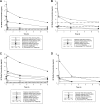Effect of Clinically Meaningful Antibiotic Concentrations on Recovery of Escherichia coli and Klebsiella pneumoniae Isolates from Anaerobic Blood Culture Bottles with and without Antibiotic Binding Resins
- PMID: 31533981
- PMCID: PMC6879289
- DOI: 10.1128/JCM.01344-19
Effect of Clinically Meaningful Antibiotic Concentrations on Recovery of Escherichia coli and Klebsiella pneumoniae Isolates from Anaerobic Blood Culture Bottles with and without Antibiotic Binding Resins
Abstract
Blood cultures are routinely collected in pairs of aerobic and anaerobic bottles. Artificial sterilization of Gram-negative bacteria in aerobic bottles containing clinically meaningful antibiotic concentrations has previously been observed. This study assessed recovery from anaerobic bottles with and without antibiotic binding resins. We studied the recovery of Escherichia coli and Klebsiella pneumoniae when exposed to meropenem, imipenem, cefepime, cefazolin, levofloxacin, and piperacillin-tazobactam in resin-containing BacT/Alert FN Plus and BD Bactec Plus anaerobic/F bottles as well as resin-free BacT/Alert SN and BD Bactec standard anaerobic bottles. Bottles were inoculated with bacteria and whole blood containing peak, midpoint, or trough concentrations and incubated for up to 120 hours in their respective detection systems. In E. coli resin-containing bottles, recovery was observed in 10/24 (42%), 17/24 (71%), and 18/24 (75%) (P = 0.034) of those exposed to peak, midpoint, and trough concentrations, respectively. In K. pneumoniae resin-containing bottles, recovery was observed in 8/16 (50%), 10/16 (63%), and 10/16 (63%) (P = 0.710), respectively. No growth was detected in bottles containing cefepime regardless of concentration, while recovery was observed in the presence of all concentrations of cefazolin and piperacillin-tazobactam. Recovery in bottles with meropenem and imipenem was more frequently observed in BacT/Alert FN Plus bottles compared with Bactec Plus bottles. Resin-free bottles demonstrated significantly lower recovery than bottles containing binding resin. Clinical concentrations of certain antibiotics can adversely affect detection of E. coli and K. pneumoniae in anaerobic blood culture bottles. Obtaining blood cultures immediately before a dose and utilizing resin-containing anaerobic bottles will maximize the likelihood of recovery.
Keywords: Escherichia coli; Klebsiella pneumoniae; antimicrobial stewardship; bacteremia; carbapenem; cephalosporin; levofloxacin; piperacillin.
Copyright © 2019 American Society for Microbiology.
Figures
References
-
- Rhodes A, Evans LE, Alhazzani W, Levy MM, Antonelli M, Ferrer R, Kumar A, Sevransky JE, Sprung CL, Nunnally ME, Rochwerg B, Rubenfeld GD, Angus DC, Annane D, Beale RJ, Bellinghan GJ, Bernard GR, Chiche JD, Coopersmith C, De Backer DP, French CJ, Fujishima S, Gerlach H, Hidalgo JL, Hollenberg SM, Jones AE, Karnad DR, Kleinpell RM, Koh Y, Lisboa TC, Machado FR, Marini JJ, Marshall JC, Mazuski JE, McIntyre LA, McLean AS, Mehta S, Moreno RP, Myburgh J, Navalesi P, Nishida O, Osborn TM, Perner A, Plunkett CM, Ranieri M, Schorr CA, Seckel MA, Seymour CW, Shieh L, Shukri KA, et al. . 2017. Surviving Sepsis Campaign: international guidelines for management of sepsis and septic shock: 2016. Crit Care Med 45:486–552. doi:10.1097/CCM.0000000000002255. - DOI - PubMed
-
- Marcos M, Soriano A, Iñurrieta A, Martínez JA, Romero A, Cobos N, Hernández C, Almela M, Marco F, Mensa J. 2011. Changing epidemiology of central venous catheter-related bloodstream infections: increasing prevalence of Gram-negative pathogens. J Antimicrob Chemother 66:2119–2125. doi:10.1093/jac/dkr231. - DOI - PubMed
Publication types
MeSH terms
Substances
LinkOut - more resources
Full Text Sources
Medical
Molecular Biology Databases
Miscellaneous


